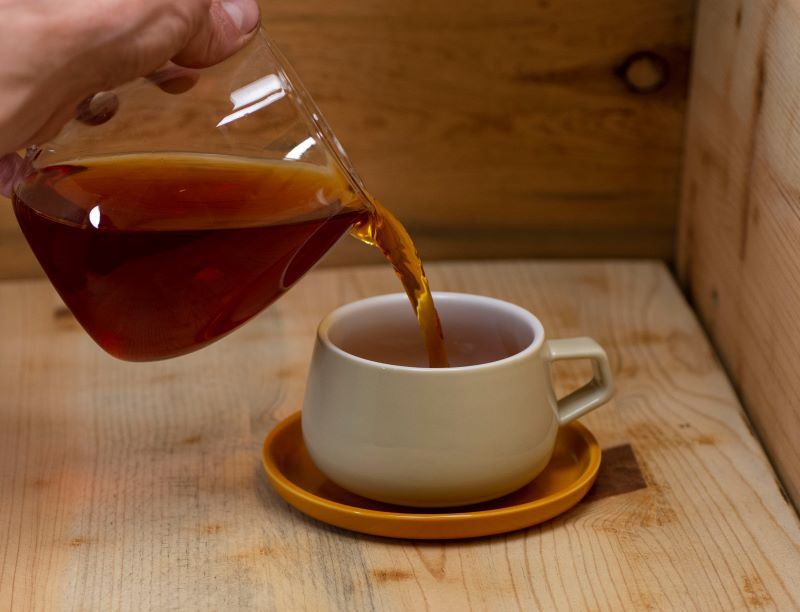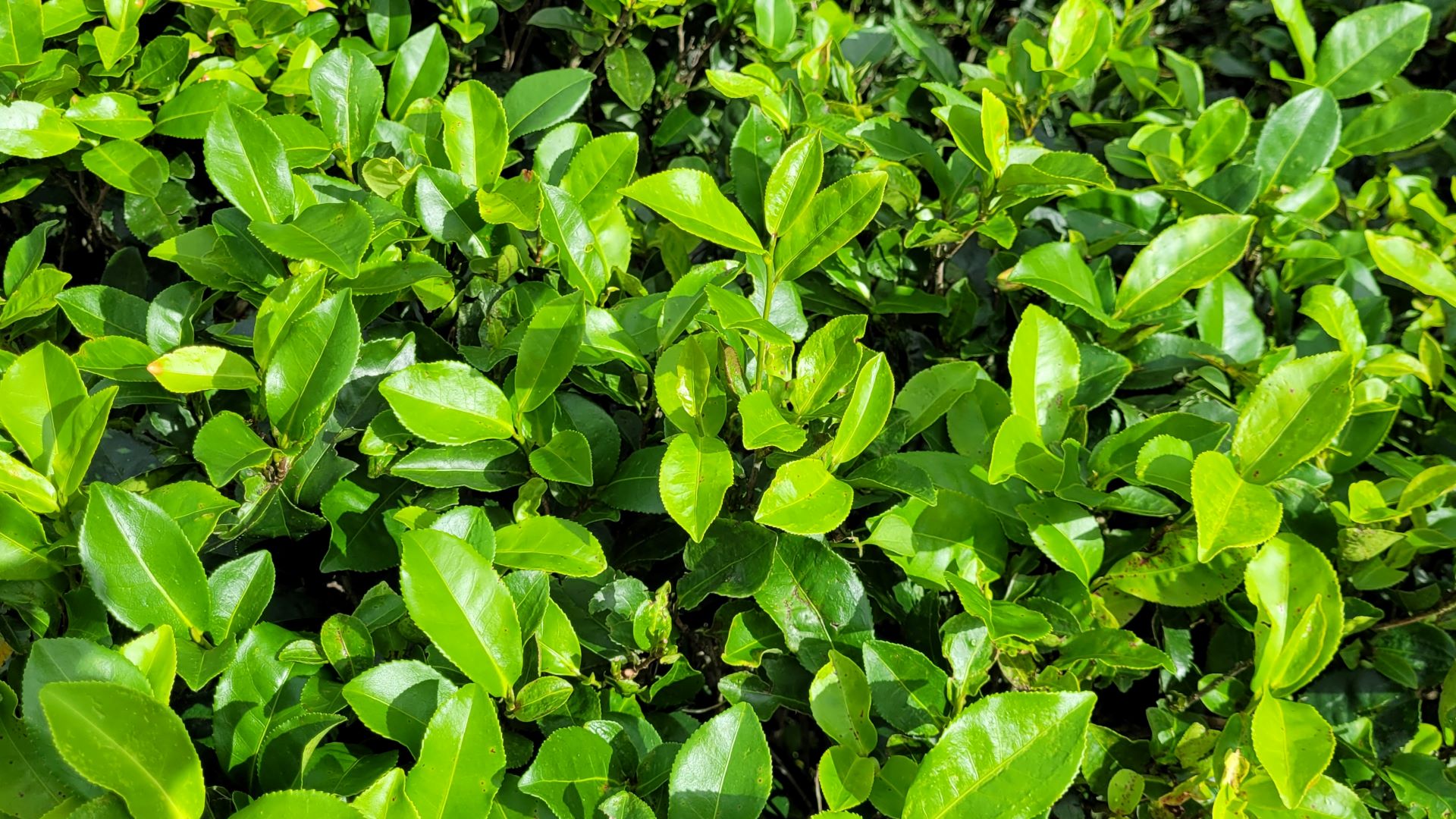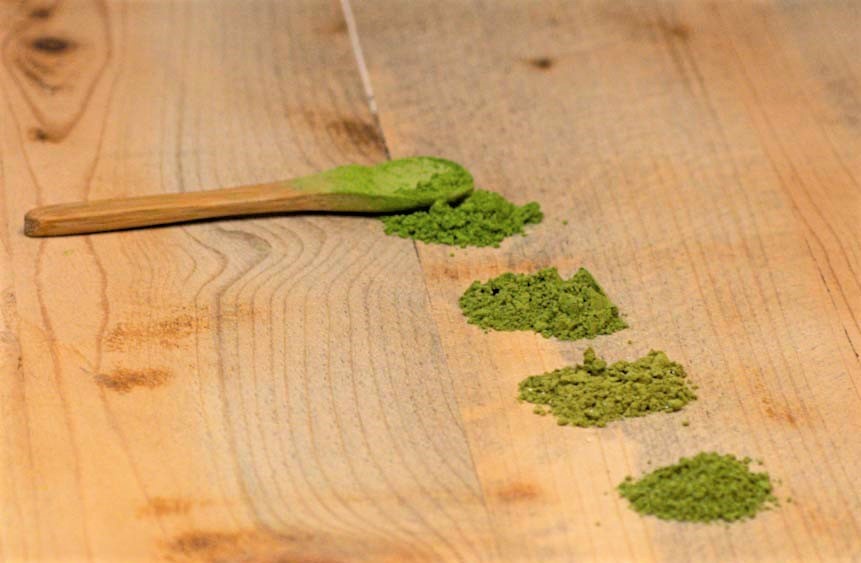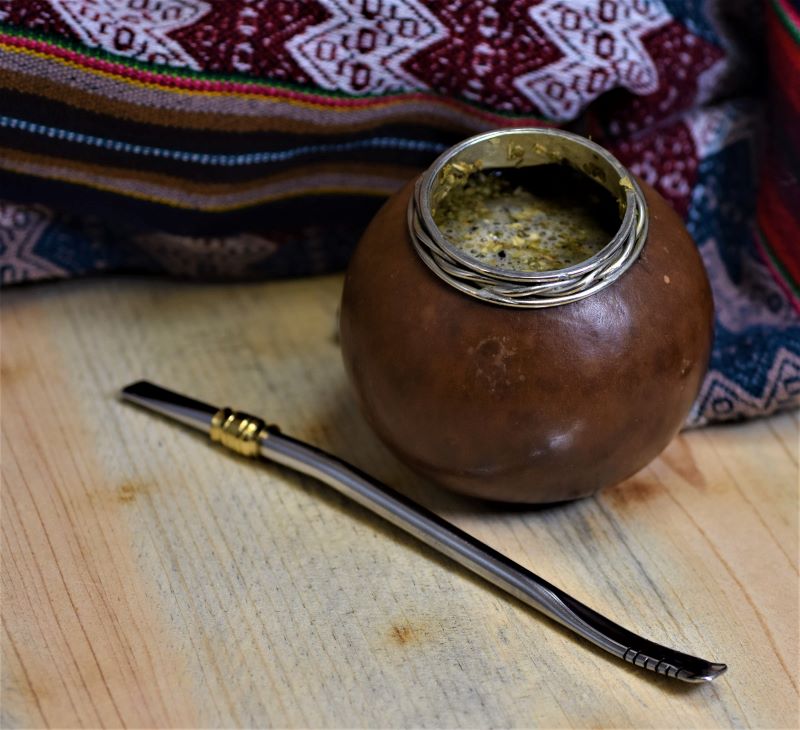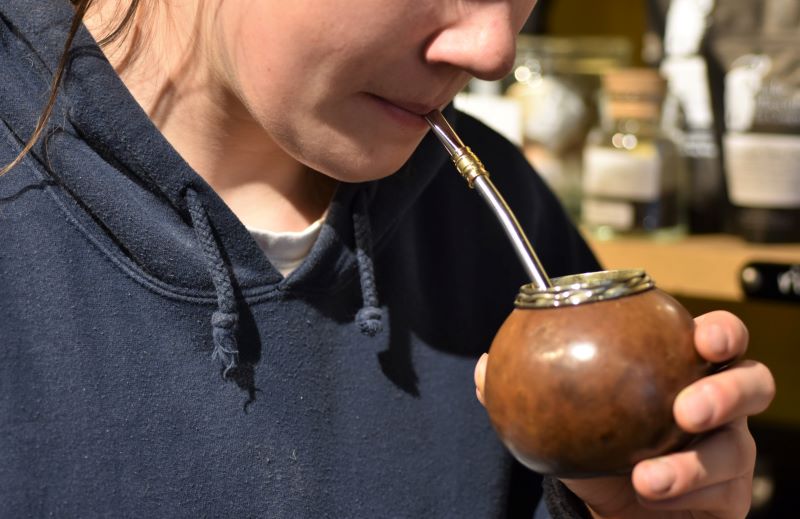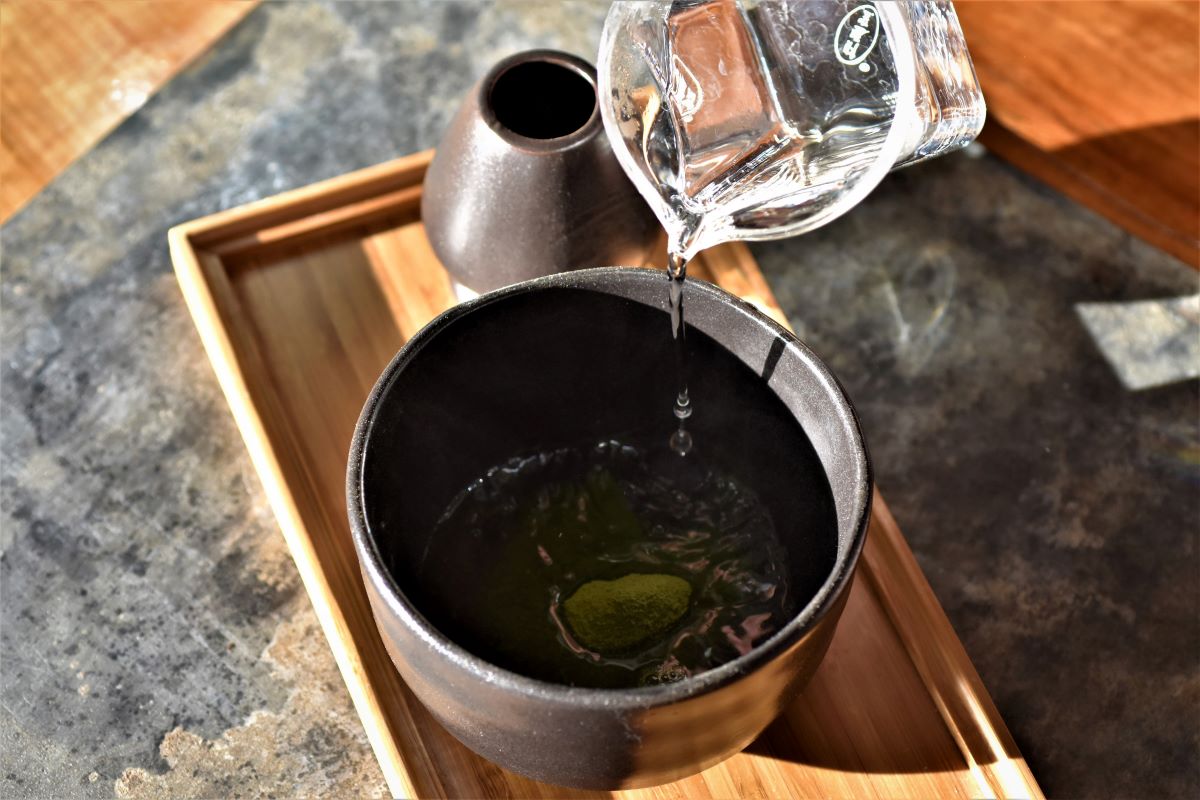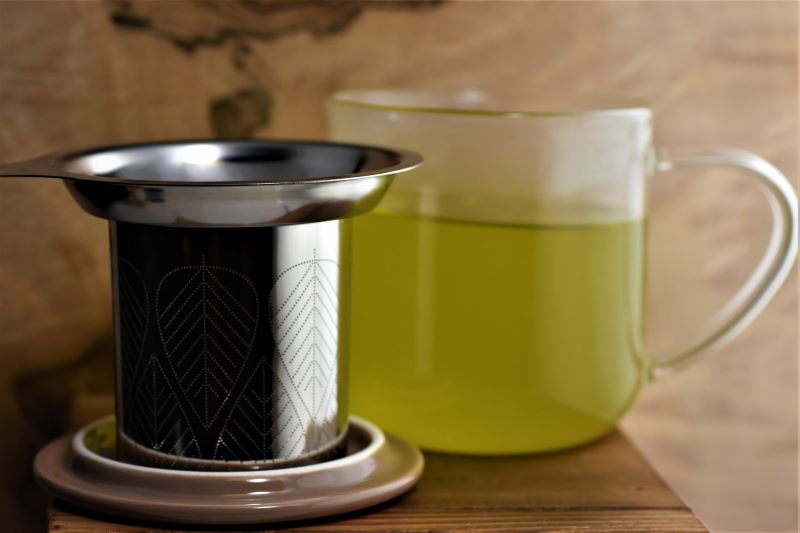We get this question A LOT. The short answer? Tea has caffeine. Herbals and botanicals (mostly) do not.
Now the long answer. “Tea” usually means any hot beverage infusion. But in technical terms, the world’s only “tea” comes from Camellia sinensis, a plant that thrives in higher elevations within our planet’s equatorial belt. These leaves get harvested and processed into the black-green-oolong-white-puerh teas we know and love. These all contain caffeine (which, fun evolutionary fact, developed in Camellia sinensis as a pest deterrent). We carry one decaf black, which goes through a chemical process to leach out most of the caffeine—much like the decaffeination process for coffee beans.
If you make an herbal infusion with ANY material besides tea leaves, it’s properly called a tisane. But we still call it “tea”—usually herbal, or botanical tea. Almost all herbal teas contain zero caffeine. (Beware a few exceptions: the South American plant yerba mate acts as a stimulant. Also, chocolate contains trace amounts of caffeine.) Look at your ingredient list. If your tea doesn’t have any “tea” in it, you can bet it’s caffeine free.
Lake Missoula marks “caffeine” or “caffeine free” on all our labels. On our website we also note “slight caffeine” for herbal-focused blends with just a little true tea.
How Much Caffeine?
The next part of this question—how MUCH caffeine does this tea have—is much harder to answer. Short answer: it depends.
Long answer: we can generalize about different tea types, but you will always find exceptions. Prepared matcha has the highest concentration of caffeine, since we consume the whole tea leaf in powder form, rather than brewing an infusion. Then the caffeine scale continues to descend: black > oolong > green > puerh > white tea.
However, terroir means everything in the tea world. Climate, elevation, and seasonal weather patterns affect everything about your tea, including caffeine levels. Other factors:
- What time of year were the leaves harvested?
- Were they newer growth (more caffeine) or older growth (less)?
- How were tea leaves processed? Oxidation levels? Finely cut leaves, or whole?
- How was the tea stored between processing and brewing?
Also remember, your brewing method makes a difference! Hotter water and longer steeps coax more caffeine from the leaves. If you reduce the water temperature, you’ll get a less potent cup. Traditional puerh brewing involves “rinsing” the tea with a short (5-20 second) discarded steep. If you want to reduce your caffeine intake, you can try this method with any tea.
The L-Theanine Factor
Caffeine interacts with the body in complex ways. Tea contains L-theanine, an amino acid that (among other things) regulates caffeine absorption. While many coffee drinkers experience a frantic high, followed by a sharp crash, tea drinkers tend to experience a smoother, more evenly sustained caffeine high. L-theanine also seems to encourage restful sleep, better concentration, and improved immune function. I’ll drink to that!
Written by Nathan B.
Enjoy the many ways to make matcha. You’ve heard matcha is good for you, that it will prevent disease and cancer, and make you feel great. This is all true, but there is a learning curve when it comes to preparing your matcha. Better prep = better flavor = more reasons to enjoy it. Good matcha is half the battle. Fortunately, you’ve come to the right place! There’s a lot of matcha out there, and it’s not all grown, manufactured, or stored with the same level of care—which difference you will taste. Matcha tea is a sensitive product, and proper storage and care is important for maintaining quality.
Find the Matcha Drink for You
There are many ways to make and enjoy matcha. Finding the method that helps you drink the most is the fun part. The drink you like, and the one you’ll drink most often, is the best matcha for you!
Matcha Latte
Adding milk to beverages, like tea and coffee, makes the very popular latte! We add 2g of matcha, 2 ounces of half and half (or a dairy free milk), a splash of honey, and about 6 ounces water for our matcha lattes. Our matcha lattes are around 8 ounces. You can make this drink with hot or cold water. It’s a cup of creamy goodness with a boost of energy.
The Basic Matcha
The style of matcha used in the Japanese tea ceremony is matcha in its cleanest form. The Japanese have perfected this drink to a ritual embedded in their culture. People can spend a lifetime fine-tuning the Japanese tea ceremony. At its heart, you need around 2g of matcha, water around 185 degrees, a bowl, and a bamboo whisk. Improvise if you don’t have a whisk, but remember, the whisking brings a creamy froth to this drink, enhancing the flavor experience.
The Matcha Palmer
This green tea take on an Arnold Palmer will make your tongue tingle. Simply add 2-4g of matcha and around 20 ounces of cold water, whisk so there are no matcha clumps, and finally add about 14 ounces of lemonade. For a 16 ounce drink, you’ll want 2/3 matcha to 1/3 lemonade. Adjust to your liking. This Matcha Palmer makes summer taste good!
Matcha Chai
Yes, you can add spices and cream to your matcha! Folks love it. If you are familiar with our House Chai Mix (a powder blend mixed with sweetened condensed milk), simply add the amount that works for you. Stir and enjoy.
Add Matcha to Smoothies, Water Bottles, and Baked Goods
You can ingest more matcha by adding it to your smoothies. Start with small amounts and adjust to your liking. You can also drink more matcha by adding a small amount to your water bottle; again, add the amount that tastes the best for you. You’ll need to experiment, but this is a quick and easy way to get your daily matcha. Lastly, add small amounts to your baked goods. Expect it to turn your muffin green!
Drink More Matcha!
Make these ideas your own, and enjoy the many ways to make matcha. If your goal is to get more matcha in your life, we hope this inspires you in the right direction!
Written by Heather Kreilick
Enjoy the many ways to make matcha. You’ve heard matcha is good for you, that it will prevent disease and cancer, and make you feel great. This is all true, but there is a learning curve when it comes to preparing your matcha. Better prep = better flavor = more reasons to enjoy it. Good matcha is half the battle. Fortunately, you’ve come to the right place! There’s a lot of matcha out there, and it’s not all grown, manufactured, or stored with the same level of care—which difference you will taste. Matcha tea is a sensitive product, and proper storage and care is important for maintaining quality.
Find the Matcha Drink for You
There are many ways to make and enjoy matcha. Finding the method that helps you drink the most is the fun part. The drink you like, and the one you’ll drink most often, is the best matcha for you!
Matcha Latte
Adding milk to beverages, like tea and coffee, makes the very popular latte! We add 2g of matcha, 2 ounces of half and half (or a dairy free milk), a splash of honey, and about 6 ounces water for our matcha lattes. Our matcha lattes are around 8 ounces. You can make this drink with hot or cold water. It’s a cup of creamy goodness with a boost of energy.
The Basic Matcha
The style of matcha used in the Japanese tea ceremony is matcha in its cleanest form. The Japanese have perfected this drink to a ritual embedded in their culture. People can spend a lifetime fine-tuning the Japanese tea ceremony. At its heart, you need around 2g of matcha, water around 185 degrees, a bowl, and a bamboo whisk. Improvise if you don’t have a whisk, but remember, the whisking brings a creamy froth to this drink, enhancing the flavor experience.
The Matcha Palmer
This green tea take on an Arnold Palmer will make your tongue tingle. Simply add 2-4g of matcha and around 20 ounces of cold water, whisk so there are no matcha clumps, and finally add about 14 ounces of lemonade. For a 16 ounce drink, you’ll want 2/3 matcha to 1/3 lemonade. Adjust to your liking. This Matcha Palmer makes summer taste good!
Matcha Chai
Yes, you can add spices and cream to your matcha! Folks love it. If you are familiar with our House Chai Mix (a powder blend mixed with sweetened condensed milk), simply add the amount that works for you. Stir and enjoy.
Add Matcha to Smoothies, Water Bottles, and Baked Goods
You can ingest more matcha by adding it to your smoothies. Start with small amounts and adjust to your liking. You can also drink more matcha by adding a small amount to your water bottle; again, add the amount that tastes the best for you. You’ll need to experiment, but this is a quick and easy way to get your daily matcha. Lastly, add small amounts to your baked goods. Expect it to turn your muffin green!
Drink More Matcha!
Make these ideas your own, and enjoy the many ways to make matcha. If your goal is to get more matcha in your life, we hope this inspires you in the right direction!
Written by Heather Kreilick
Yerba Maté (Ilex paraguariensis)
If you love botanicals, but still want a boost of caffeine, yerba maté may be for you! Yerba maté is herbal, but has plenty of caffeine to fuel you through your day. Read more information on this botanical form of caffeine, and how to incorporate it into your tea-drinking routine!
Origins & Traditions
Yerba maté comes from the dried leaves harvested from an evergreen tree native to South American Atlantic rainforests. It is primarily harvested by yerbateros (cultivators) on small farms in Paraguay, Argentina, and Brazil. In Argentina, “yerba maté” originally translated as “the gourd herb”, i.e. the herb one drinks from a gourd. The indigenous Guarani people who first used it call it ka’a (“herb”).
Traditionally, after mate leaves are dried and ground, the brewer fills a dried hollowed calabash gourd with the leaves and hot water. Using a special metal straw (or bombilla), close friends or family drink the caffeine-rich, stimulating tea in a rotating fashion. Take a sip and pass it on! The recipient gives thanks, drinks the few mouthfuls in the container, and then returns the maté to the brewer, who refills it and passes it to the next person in clockwise order.
In southern Chile, the ritual differs a bit. The recipient does not give thanks until he or she finishes drinking. This strong social and cultural tradition brings people together and creates community. Being offered maté is a sign of respect, and in many instances an important precursor to making new friends on the road.
Maté Properties
Yerba maté leaves contain 24 different vitamins and minerals, alkaloids, 15 amino acids, and abundant polyphenols, making it a highly nourishing drink! The 85 mg of caffeine in a cup of maté (along with several other chemicals) stimulate the brain, heart, and muscles lining the blood vessels. The average caffeine quantity of a cup of maté is less than coffee, but more than black tea.
“Stimulating like coffee, euphoric like chocolate, and with the health benefits of tea,” yerba maté is not for the faint of heart. It acts as a tonic, laxative diuretic, muscle relaxant, and can reduce appetite. It may also increase intellectual vigor. Some say it helps with diabetes, lowering blood sugar when taken regularly. Similar attitudes believe it can help lower LDL cholesterol or “bad” cholesterol.
As with all herbs, opt for moderation. Refrain from consuming maté if you are pregnant, nursing, or have sleep issues. Caffeine also slows blood clotting, so people with bleeding disorders should avoid it. Overall, maté should not be consumed in large amounts due to its high caffeine content.
Flavor Profile & Fun Blends
When yerba maté leaves are harvested, they are often dried by a wood fire, imparting the roasty flavor that maté is known for. Maté also turns rather bitter if steeped for a long time. Some maté lovers crave this bitterness, whereas others may choose a shorter steeping time, or use fewer leaves, to limit the bitter flavor.
Yerba maté adds depth and dimension to tea blends! Its herb-like taste fits well with other botanicals, and its kick of caffeine can also be beneficial. We incorporate yerba maté into these blends: Beat the Snot Out of You, Spicy Yerba Chai, Have a Headache?, and Sabertooth Green. And of course, we also sell straight yerba and authentic gourds!
Written by: Greta de la Montagne, edited by: Boo Curry and Heather Kreilick
Brewing loose leaf tea is very simple! These tips will help you get the most out of your tea cup.
Water, Temperature, Time, & Storage
Water The Chinese say, “Water is the mother of tea.” Good water can elevate the taste of bad tea, and poor water can diminish good tea flavor. Depending on your location, filtered water is typically best.
Temperature & Time Brew black, dark, and most oolongs at just under a boil (200°F to 212°F). Tea should never taste bitter or harsh. If it does, try cooler water or a shorter steep. A thermometer can help, but it’s not necessary.
Try brewing loose leaf green and white tea (~170°F) when your kettle starts to rumble, but before the sound deepens. You can also let boiled water sit for a few minutes, or add a little cold water. If you experiment and then note how your tea responds, you’ll find your method.
Most botanicals (or herbal teas) prefer boiling (212°F) water. The flavor intensifies with time, so steeping time can vary depending on your preference. Some botanicals improve the longer they steep. Follow your taste buds.
Steeping Device Loose leaf tea will expand while brewing, so use a vessel with plenty of space, you’ll get a better flavor. Try brewing more than once: many teas are good for two or more steeps, even some large-leaf black teas.
Storage Light and air degrade tea quality. Press the air out of your storage bag, your tea will stay fresh longer.
Tea Basics
All proper tea comes from the same plant, Camellia sinensis. Variation in flavor develops with a) the climate and soil of different growing regions and b) how the tea is processed: black, oolong, green, white, and Puerh teas. The concept around the flavor of tea and why it varies is called terroir.
Caffeine All tea has caffeine, although the less-oxidized teas (green, white), which steep up best at a cooler temperature, will have less. Most caffeine infuses in the first 30 seconds of brewing loose leaf tea; if you want to reduce your caffeine intake, you can pour off a first, short steep and then brew again as usual.
Single-origin A single tea from just one tea farm is referred to as a single origin tea and offers its own unique flavor. A few of our tea blends, like our breakfast teas, combine single-origin teas. Other blends add botanicals, spices, fruit, and natural flavoring to evoke different exciting flavors.
Rooibos Red tea, or Rooibos, and its cousin Honeybush, grow exclusively in a region of South Africa. Both steep up full-bodied and deliver high levels of antioxidants, but without the caffeine. Many of our favorite herbal blends use these as a base.
Botanicals The rest of the tea world—botanicals (herbal and caffeine-free)—is vast and complex: anything you can pour hot water on! Many flowers and herbs have their own long history and lore, which means there’s always another tea you haven’t tried yet.
Once you start brewing loose leaf tea, you’ll taste the difference, and you’ll never back!
Written by Nathan Bendickson
A few years ago, I switched from drinking coffee to tea entirely. I stopped drinking coffee because it made me feel jittery and anxious. Plus, it really upset my stomach. The caffeine in tea releases at a much steadier pace, and I never experience the “caffeine drop” when I drink tea. With the wide variety of blends, I never seem to run out of something I crave, and my daily hydration level has greatly improved.
Since dropping coffee from my daily routine, I am going through about 50 grams of tea per week. I find myself drinking tea throughout the day. I start with caffeinated teas in the morning, such as Willy Wonka, Mammoth Red and Creamy Coconut Oolong. In the late afternoon, I like to switch to rooibos and botanical blends. Some of the ones I like include Cape Town Grey, Sassy Citrus and Spice and Evening Chai.
If you experience jitters, anxiety or an upset stomach when drinking coffee, it might be time for you to explore the tasty world of tea.
Written by Gunilla Gillette





